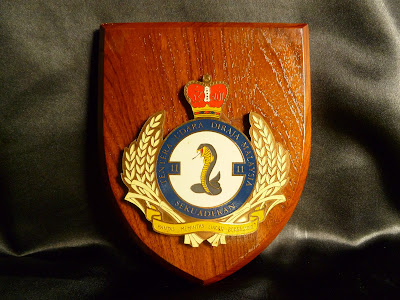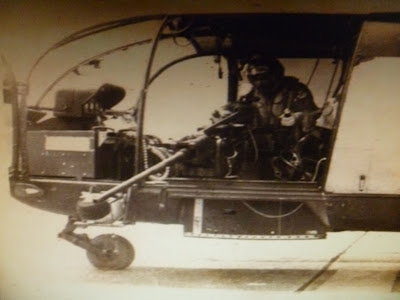Saya kerapkali ditanya dengan banyak soalan-soalan oleh kawan-kawan dan saudaramara yang ingin tahu tentang pekerjaan saya semasa dalam TUDM. Ini berlaku apabila bertemu semasa dalam majlis-majlis kenduri, semasa ziarah menziarah kawan dan saudaramara. Saya percaya kita semua tidak dapat elak daripada perkara seperti ini, hanya dengan berterus terang sahaja dapat kita menceritakan perkara-perkara yang sebenar walaupun mereka kurang yakin dengan cerita-cerita yang diberikan dan justeru itu saya mulakan dengan menulis "Blog" supaya kemunculan blog saya akan memberikan keyakinan diri mereka terhadap saya dan TUDM. Ini lah jenis-jenis soalan serta jawapan-jawapan yang dapat saya sampaikan.
S : Berapa lamakah anda berkidmat dalam TUDM(RMAF)?
J : Berkidmat selama dua puloh dua tahun (1970-1992).
S : Lepas bersara buat apa?
J : Dapat kerja sebagai "Pegawai Pentadbir" di sebuah syarikat swasta.
S : Betulkah orang kata askar selepas bersara hanya dapat kerja sebagai jaga(security guard),pemandu bas dan lori?
J : Tidaklah semua mestinya begitu.
S: Bagaimana anda boleh dapat jawatan sebagai "Pegawai Pentadbir" tersebut?
J : Nasib saya dikatakan baik juga sebab ada mempunyai "Adv.Dip.Business and Administration.,UK."
S: Dalam blog anda, anda adalah seorang yang berpangkat "Pegawai Waran II" mengapa pula anda mempunyai banyak bidang profesion yang lain seperti logistik, airgunner, navigator, fotografi udara, dan lain-lain?
J : Itu memanglah perkara biasa dan ianya merupakan aset penting dalam TUDM dan keperibadian.
S : Seronok jadi airgunner?
J : Profesion tersebut memanglah menjadi kebanggaan saya.
S : Pernahkah anda merasa takut semasa menjalankan tugas sebagai airgunner di udara?
J : Perasaan takut akan hilang apabila semangat untuk berjuang itu tinggi, lebih-lebih lagi dapat menggunakan senjata-senjata yang dipasang pada helicopter tersebut semasa menggempor.
Bersambung....pada 16 Dis,2010.
S : Mengapa anda tidak memohon menjadi pegawai TUDM?
J : Dulu pada tahun 1972 saya pernah memohon tetapi gagal walaupun saya menpunyai Cambridge School Certificate(OSC/MCE) 1968.
S : Mengapa tidak memohon lagi?
J : Ketika itu saya lebih selesa dengan pangkat yang sedia ada kerana ianya dalam sekim pencen.
S : Bukankah pegawai mempunyai sekim pencen?
J : Ya benar! pada pegawai yang bertauliah jangka tetap sahaja, dan bukan pada tauliah jangka pendek.
S : Bukankah ada sekim kenaikan lain-lain pangkat terus kepada pegawai?
J : Ada! memang tersebut dalam Akta Angkatan Tentera 1972 dulunya dikenali sebagai Malay Regiment Enactment(MRE) tetapi ianya tidak diperaktikan secara meluas oleh TUDM ketika itu.
S : Mengapa begitu?
J : Kemungkinan peruntukan kenaikan pangkat secara terus terhad pada ketika itu jika dibandingkan dengan sekarang, di mana ramai lain-lain pangkat telah dinaikan terus ke pegawai. Kalau tidak silap saya ianya telah bermula secara meluas pada tahun1991 terutama sekali daripada bidang kejuruteraan dalam TUDM.
S : Adakah anda merasa ketinggalan kerana tidak menjadi pegawai?
J : Tidak pula saya merasai sedemikian, dan jikalau saya menjadi pegawai, siapa pula nak jadi Pegawai Waran.
S : Mengapa anda masih berpaut kepada pangkat Pegawai Waran?
J : Pangkat Pegawai Waran adalah pencapaian pangkat yang tertinggi dalam kalangan lain-lain pangkat rendah dan ianya amat disegani oleh pegawai-pegawai atasan, serta berkebolehan dalam bidang profesionnya, berpengalaman, tahap displin dan mempunyai kepimpinan yang tinggi. Pegawai Waran merupakan "General of the other rank" yang selalu disegani dan dihormati oleh anak-anak buahnya.
S : Bagaimana hendak sampai kepada tahap pangkat Pegawai Waran dalam TUDM?
J : Dalam TUDM, selain daripada memperolehi kemahiran dan beberapa tahun pengalaman berkidmat, calon-calon untuk Pegawai Waran mestilah wajib lulus "Kursus Kaedah Mengajar", dan "Kursus Pegawai Waran" daripada Institut Teknologi Udara, Kinrara.
S : Mengapa anda tidak memohon menjadi pegawai TUDM?
J : Dulu pada tahun 1972 saya pernah memohon tetapi gagal walaupun saya menpunyai Cambridge School Certificate(OSC/MCE) 1968.
S : Mengapa tidak memohon lagi?
J : Ketika itu saya lebih selesa dengan pangkat yang sedia ada kerana ianya dalam sekim pencen.
S : Bukankah pegawai mempunyai sekim pencen?
J : Ya benar! pada pegawai yang bertauliah jangka tetap sahaja, dan bukan pada tauliah jangka pendek.
S : Bukankah ada sekim kenaikan lain-lain pangkat terus kepada pegawai?
J : Ada! memang tersebut dalam Akta Angkatan Tentera 1972 dulunya dikenali sebagai Malay Regiment Enactment(MRE) tetapi ianya tidak diperaktikan secara meluas oleh TUDM ketika itu.
S : Mengapa begitu?
J : Kemungkinan peruntukan kenaikan pangkat secara terus terhad pada ketika itu jika dibandingkan dengan sekarang, di mana ramai lain-lain pangkat telah dinaikan terus ke pegawai. Kalau tidak silap saya ianya telah bermula secara meluas pada tahun1991 terutama sekali daripada bidang kejuruteraan dalam TUDM.
S : Adakah anda merasa ketinggalan kerana tidak menjadi pegawai?
J : Tidak pula saya merasai sedemikian, dan jikalau saya menjadi pegawai, siapa pula nak jadi Pegawai Waran.
S : Mengapa anda masih berpaut kepada pangkat Pegawai Waran?
J : Pangkat Pegawai Waran adalah pencapaian pangkat yang tertinggi dalam kalangan lain-lain pangkat rendah dan ianya amat disegani oleh pegawai-pegawai atasan, serta berkebolehan dalam bidang profesionnya, berpengalaman, tahap displin dan mempunyai kepimpinan yang tinggi. Pegawai Waran merupakan "General of the other rank" yang selalu disegani dan dihormati oleh anak-anak buahnya.
S : Bagaimana hendak sampai kepada tahap pangkat Pegawai Waran dalam TUDM?
J : Dalam TUDM, selain daripada memperolehi kemahiran dan beberapa tahun pengalaman berkidmat, calon-calon untuk Pegawai Waran mestilah wajib lulus "Kursus Kaedah Mengajar", dan "Kursus Pegawai Waran" daripada Institut Teknologi Udara, Kinrara.
S : Apakah detik yang paling pahit sekali semasa bertugas dengan TUDM?
J : Semasa peristiwa terhempasnya sebuah pesawat Nuri di Sungai Lundu, Kuching, Sarawak pada 18 Dis, 1989 yang meragut nyawa kesemua 16 penumpang anggota tentera Malaysia termasuk Pegawai Pemerentah Div.ke2, Mej.Jen.Datuk Mustaffa Awang dan Pemerentah Brigade Infantry ke3, Brig.Jen.Datuk Hasbullah Yusoff, serta juruterbang dan anak-anak kapal...Al-Fatihah.




















































